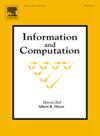罗宾逊空间中的模块和 PQ 树
IF 1
4区 计算机科学
Q3 COMPUTER SCIENCE, THEORY & METHODS
引用次数: 0
摘要
Robinson空间是n个点上存在相容序的不相似空间(X,d),即全序<;使得X <;y<;z意味着d(X,y)≤d(X,z)且d(y,z)≤d(X,z)。识别一个不相似空间是否为鲁滨逊空间在序列化和分类中有许多应用。Robinson空间的所有相容阶的集合可以用一个pq树来简洁地表示,pq树是Booth和Lueker引入的一种经典数据结构。一个M模是X的一个子集M,它与M的外部是不可区分的,即从X × M的任何一点到M的所有点的距离是相同的。模块的层次结构也可以用树来表示:不相似空间(X,d)的模块树。在本文中,我们建立了pq树与Robinson空间的模树之间的对应关系。更准确地说,我们展示了如何从Robinson不相似度的pq树构造Robinson不相似度的模树,反之亦然。为了建立这种转换,我们引入罗宾逊空间的δ-图Gδ和δ-m模块的概念,它们是Gδ的连通分量。所有这些结果也导致了构造Robinson空间的pq树和mmodule树的最优O(n2)时间算法。本文章由计算机程序翻译,如有差异,请以英文原文为准。
Modules and PQ-trees in Robinson spaces
A Robinson space is a dissimilarity space on n points for which there exists a compatible order, i.e. a total order < on X such that implies that and . Recognizing whether a dissimilarity space is Robinson has numerous applications in seriation and classification. The set of all compatible orders of a Robinson space can be succintly represented by a PQ-tree, a classical data structure introduced by Booth and Lueker. An mmodule is a subset M of X which is not distinguishable from the outside of M, i.e. the distances from any point of to all points of M are the same. The hierarchical structure of mmodules can also be represented by a tree: the mmodule-tree of a dissimilarity space .
In this paper, we establish correspondences between the PQ-trees and the mmodule-trees of Robinson spaces. More precisely, we show how to construct the mmodule-tree of a Robinson dissimilarity from its PQ-tree and vice versa. To establish this translation, we introduce the notions of δ-graph of a Robinson space and of δ-mmodules, the connected components of . It also involves the dendrogram of the subdominant ultrametric of d. All these results also lead to optimal time algorithms for constructing the PQ-tree and the mmodule tree of Robinson spaces.
求助全文
通过发布文献求助,成功后即可免费获取论文全文。
去求助
来源期刊

Information and Computation
工程技术-计算机:理论方法
CiteScore
2.30
自引率
0.00%
发文量
119
审稿时长
140 days
期刊介绍:
Information and Computation welcomes original papers in all areas of theoretical computer science and computational applications of information theory. Survey articles of exceptional quality will also be considered. Particularly welcome are papers contributing new results in active theoretical areas such as
-Biological computation and computational biology-
Computational complexity-
Computer theorem-proving-
Concurrency and distributed process theory-
Cryptographic theory-
Data base theory-
Decision problems in logic-
Design and analysis of algorithms-
Discrete optimization and mathematical programming-
Inductive inference and learning theory-
Logic & constraint programming-
Program verification & model checking-
Probabilistic & Quantum computation-
Semantics of programming languages-
Symbolic computation, lambda calculus, and rewriting systems-
Types and typechecking
 求助内容:
求助内容: 应助结果提醒方式:
应助结果提醒方式:


